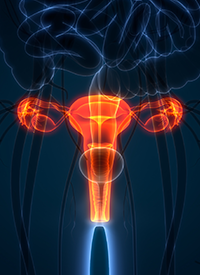Article
Lenvatinib Plus Pembrolizumab Produces Deep, Sustained Responses in Advanced Endometrial Cancer
Author(s):
The combination of lenvatinib plus pembrolizumab produced deep, durable tumor responses in both all-comer and mismatch repair–proficient (pMRR) populations of patients with advanced endometrial cancer, according to data from the phase 3 Study 309/KEYNOTE-775 trial.
Image Credit: © magicmine - stock.adobe.com

The combination of lenvatinib (Lenvima) plus pembrolizumab (Keytruda) produced deep, durable tumor responses in both all-comer and mismatch repair–proficient (pMRR) populations of patients with advanced endometrial cancer, according to data from the phase 3 Study 309/KEYNOTE-775 trial (NCT03517449) presented at the 2023 Society of Gynecologic Oncology (SGO) Annual Meeting on Women’s Cancer.
In the all-comer population, the overall response rate (ORR) was 33.8% (95% CI, 29.3%-38.6%), which included a complete response (CR) rate of 7.5% (95% CI, 5.2%-10.5%) and a partial response rate of 26.3% (95% CI, 22.1%-30.8%); investigators confirmed a total of 33.8% of responses.
The median time to response (TTR) was 2.1 months (range, 1.5-23.0), and the median duration of response (DOR) was 12.9 months. Extended responses occurred in 73.7%, 51.8%, and 39.5% of patients at the 6 months or more, 12 months or more, and 24 months or more timepoints, respectively. Moreover, 76.3% of patients had a 50% or more reduction in tumor diameter, and 43.2% had a 75% or more reduction.
In patients who were mismatch repair proficient (pMMR), the ORR was 32.4% (95% CI, 27.5%-37.6%) and included a CR rate of 5.8% (95% CI, 3.6%-8.8%) and a PR rate of 26.6% (95% CI, 22.0%-31.6%). Moreover, 32.4% of responses were confirmed.
The median TTR was 2.1 months (range, 1.5-23.0), and the median DOR was 9.3 months. Extended response at 6 months or more, 12 months or more, and 24 months or more, occurred in 68.9%, 44.1%, and 31.4% of patients, respectively. Additionally, 71.4% and 42.0% of patients had tumor diameter reductions of 50% or more and 75% or more, respectively.
In the trial's primary analysis, investigators identified statistically significant and clinically meaningful improvements in efficacy following treatment with the combination in patients with previously treated disease vs chemotherapy. Moreover, the final overall survival (OS) analysis identified treatment-emergent adverse effects (TEAEs) in 99.8% of all-comers who received lenvatinib and pembrolizumab, with 90.1% of patients having grade 3 or higher TEAEs.
At the meeting, investigators also presented a poster with additional tumor response analyses for the experimental arm.
The study included patients with advanced endometrial cancer who received at least 1 previous platinum-based chemotherapy regimen. Patients also needed to have measurable disease by blinded independent central review, have an ECOG performance status of 0 or 1, and have tissue available for MMR testing. Investigators stratified patients based on region, ECOG performance status, and history of pelvic radiation.
Patients were randomly assigned 1:1 to receive 20 mg of oral lenvatinib daily plus 200 mg of pembrolizumab intravenously once every 3 weeks or 60 mg/m2 of doxorubicin once every 3 weeks or 80 mg/m2 of paclitaxel weekly using a 3 weeks on, 1 week off schedule.
Primary end points included OS and progression-free survival (PFS), and key secondary end points were ORR, health-related quality of life, pharmacokinetics, and safety. The trial also had DOR as an exploratory end point.
The exploratory analysis focused on further assessing treatment duration and efficacy as well as safety in patients receiving lenvatinib and pembrolizumab with CR or PR as a best response. Among patients who received the combination regimen (n = 411), 346 had pMMR disease.
In terms of responses based on baseline patient characteristics, ORR was comparable regardless of endometrioid and non-endometrioid histology in both the pMMR (32.3% and 32.5%) and all-comer populations (34.8% and 32.3%). Comparable responses also occurred in patients who received 1 vs 2 prior lines of therapy in both the pMMR (32.2% and 33.3%) and all-comer groups (33.2% and 35.6%).
However, patients with 3 or more lines of therapy had slightly lower ORRs in the pMMR (20.0%) and all-comer arms (27.3%), although it's worth noting that this population included 10 patients with pMMR disease and 11 all-comers.
In patients who responded to treatment, the median PFS was 13.8 months (95% CI, 11.6-18.4) in those who had pMMR disease and 16.7 months (95% CI, 13.0-21.2) in all-comers. Additionally, the median OS was 31.1 months (95% CI, 25.8-not estimable [NE]) vs NE (95% CI, 31.0-NE) in those who responded in the pMMR and all-comer populations, respectively.
Reference
Makker V, Lorusso D, Moore R, et al. Characterization of tumor response with lenvatinib plus pembrolizumab in study 309/KEYNOTE-775. Presented at: 2023 Annual Meeting on Women’s Cancer; March 25-28; Tampa, Florida.









